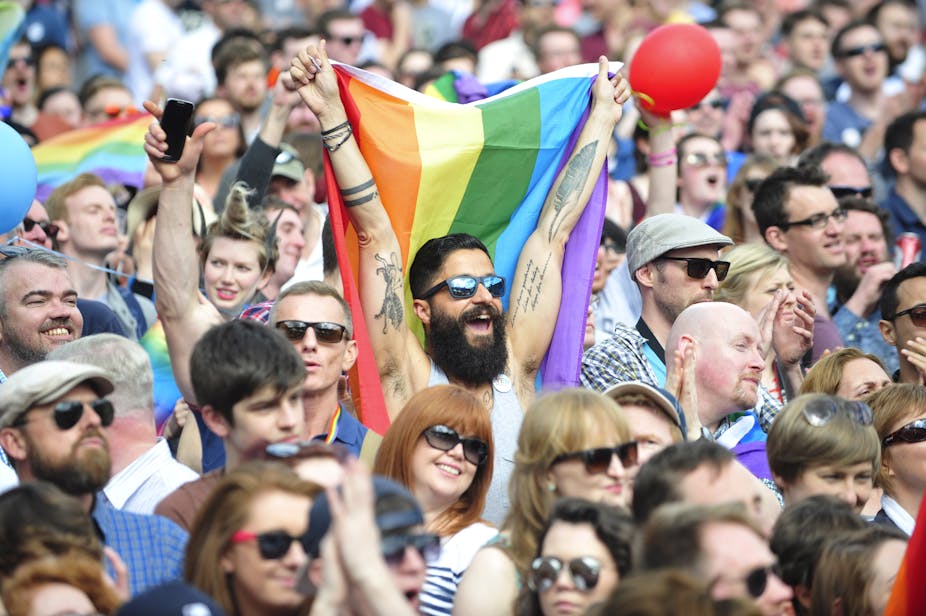By a margin of two to one, and a total majority of 62% to 38%, the people of Ireland have voted yes to equal marriage. The win by the yes campaign for same-sex marriage has been carried by a much bigger margin than the polls predicted; almost unanimous across every constituency in the country. In what some describe as more of a “social movement” for change, rather than a constitutional referendum, the referendum prompted an unprecedented high turnout, spearheaded by younger people, and an engaging and crucial social media campaign for a yes vote.
The result is remarkable, given that homosexuality was only decriminalised in Ireland in 1993 after a ruling by the European Court of Human Rights. In the context of austerity and continuing protests over water charges, Ireland has switched gears for this referendum, adjusting from explicitly political and economic goals, to moral ones.
This historic event in Ireland is characterised by a number of firsts:
-
Ireland is the first country in the world to have a referendum on legalising same-sex marriage. Although some 20 other countries worldwide have already legalised gay marriage, Ireland is the first to do so through a popular vote.
This is the first referendum in Ireland in which all the main political parties supported the same campaign. All political parties in the Dail (parliament) have endorsed the marriage equality proposal, with just five of the 226 members of parliament publicly announcing they would vote against.
A decisive element for holding the referendum at all was that the citizen-based Constitutional Convention recommended the holding of a referendum in the lifetime of the current government.
The referendum turnout at 60.5% was the highest in the country since the 1937 constitutional referendum and as high as the 1972 referendum on Ireland’s entry into the then European Economic Community.
Almost all constituencies voted yes, which is significant given that a predicted rural-urban divide did not materialise, demonstrating the massive shift in public opinion right across Ireland. Rural areas which voted strongly against divorce in a previous referendum swung behind the “social movement” for a yes vote. For example, when Ireland legalised divorce by a very thin majority in 1995, only five of the 30 constituencies outside Dublin backed the proposal. This trend was not repeated in this referendum.
An extraordinary number of Irish citizens living abroad came home to vote (overwhelmingly for the yes campaign), and the power of social media was clear as a key ingredient the success of the yes campaign. The hashtag #VoteYes was the top trending issue on Twitter, and there were almost 5,000 articles worldwide written about the referendum. The hashtag #hometovote was also significant for the yes campaign in bringing Irish people home to take part in the referendum, to create a different Ireland.
A generous majority
Another obvious (but still important) point here is that the majority (heterosexual citizens) voted for the extension of equality to the minority (their LGBTQ fellow citizens). One could interpret the result as the act of a “generous majority”, and of what one commentator called the “decency of the Irish people” which was not limited to the liberal leafy suburbs of south Dublin, nor the solidarity from the working-class communities of North Dublin, but also came from Donegal, Cavan, Kildare and Kerry.
With the exception of one constituency (Roscommon-South Leitrim), the yes campaign swept across the country, ranging from Dublin where it was over 70% to 75% in support of the proposal, to tighter margins in more rural areas. In many ways it is the latter which is the most significant outcome of the referendum. That is, the major change in traditionally conservative areas where the Catholic Church and traditional views of morality, family life and marriage holds sway. Even the body representing the rank and file of the Irish Police force – the Garda Representative Association – came out in favour of a yes vote.
In the end, while the result is clearly a defeat for the Catholic Church, this should not be seen as a complete rejection of Catholicism. The yes win is a sign of a more pluralistic society certainly, but also of a more liberal Catholicism out of step with the Catholic hierarchy’s vision.
Of course, there is still much work to be done to end homophobia in Ireland. But today’s popular decision is a massive step towards the fulfilment of a much-used phrase in the 1916 Irish proclamation about “cherishing all the children of the nation equally”, irrespective of sexual orientation.

Civic conversations
The mobilisation of young people and social media use were key. The buzz generated was similar to the Scottish referendum, including unprecedented numbers of mostly young Irish emigrants returning to vote. But older people voted yes, devoted Catholics voted yes, rural and urban Ireland, working class and middle class, all voted yes. There are no longer “two Irelands” – an older and rural one, versus a younger and urban one: Ireland is united on this issue.
The campaign was characterised by conversations; particularly the multiple conversations had on the doorsteps as campaigners canvassed citizens, the high profile Irish citizens who spoke out, and the common media analysis which focused on the “kitchen table” conversations that were had in homes across Ireland. A common phrase, not least form those who came home to vote, was a desire to be “part of the conversation” and make history.
As Yes Equality spokesperson Grainne Healy said: “It’s an extraordinary day. We were going out not telling people to vote yes, we were going out saying I am voting yes and I’d like to tell you why. That’s how the campaign started and that’s how it has worked.” Ireland spoke to itself, then went to vote.
There is palpable euphoria, relief and pure joy in Ireland today (not something common in politics), so we may end with a note from Yeats: “I have spread my dreams under your feet; tread softly because you tread on my dreams.”

